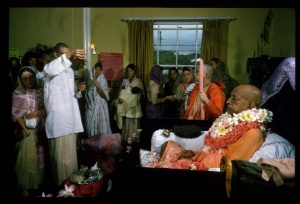CC Adi 1.77 (1975): Difference between revisions
(Vanibot #0027: CCMirror - Mirror CC's 1996 edition to form a basis for 1975) |
(Vanibot #0020: VersionCompareLinker - added a link to the Version Compare feature) |
||
| Line 2: | Line 2: | ||
<div style="float:left">'''[[Sri Caitanya-caritamrta (1975)|Śrī Caitanya-caritāmṛta (1975)]] - [[CC Adi (1975)|Ādi-līlā]] - [[CC Adi 1 (1975)|Chapter 1: The Spiritual Masters]]'''</div> | <div style="float:left">'''[[Sri Caitanya-caritamrta (1975)|Śrī Caitanya-caritāmṛta (1975)]] - [[CC Adi (1975)|Ādi-līlā]] - [[CC Adi 1 (1975)|Chapter 1: The Spiritual Masters]]'''</div> | ||
<div style="float:right">[[File:Go-previous.png|link=CC Adi 1.76 (1975)|Ādi-līlā 1.76]] '''[[CC Adi 1.76 (1975)|Ādi-līlā 1.76]] - [[CC Adi 1.78 (1975)|Ādi-līlā 1.78]]''' [[File:Go-next.png|link=CC Adi 1.78 (1975)|Ādi-līlā 1.78]]</div> | <div style="float:right">[[File:Go-previous.png|link=CC Adi 1.76 (1975)|Ādi-līlā 1.76]] '''[[CC Adi 1.76 (1975)|Ādi-līlā 1.76]] - [[CC Adi 1.78 (1975)|Ādi-līlā 1.78]]''' [[File:Go-next.png|link=CC Adi 1.78 (1975)|Ādi-līlā 1.78]]</div> | ||
{{CompareVersions|CC|Adi 1.77|CC 1975|CC 1996}} | |||
{{RandomImage}} | {{RandomImage}} | ||
==== TEXT 77 ==== | ==== TEXT 77 ==== | ||
| Line 20: | Line 19: | ||
<div class="synonyms"> | <div class="synonyms"> | ||
sva-rūpam—the | sva-rūpam—the Lord's own form; anya—other; ākāram—features of the body; yat—which; tasya—His; bhāti—appears; vilāsataḥ—from particular pastimes; prāyena—almost; ātma-samam—self-similar; śaktyā—by His potency; saḥ—that; vilāsaḥ—the vilāsa (pastime) form; nigadyate—is called. | ||
</div> | </div> | ||
| Line 27: | Line 26: | ||
<div class="translation"> | <div class="translation"> | ||
"When the Lord displays numerous forms with different features by His inconceivable potency, such forms are called vilāsa-vigrahas." | |||
</div> | </div> | ||
Latest revision as of 13:58, 26 January 2020

His Divine Grace
A.C. Bhaktivedanta Swami Prabhupada
A.C. Bhaktivedanta Swami Prabhupada
TEXT 77
- svarūpam anyākāraṁ yat
- tasya bhāti vilāsataḥ
- prāyeṇātma-samaṁ śaktyā
- sa vilāso nigadyate
SYNONYMS
sva-rūpam—the Lord's own form; anya—other; ākāram—features of the body; yat—which; tasya—His; bhāti—appears; vilāsataḥ—from particular pastimes; prāyena—almost; ātma-samam—self-similar; śaktyā—by His potency; saḥ—that; vilāsaḥ—the vilāsa (pastime) form; nigadyate—is called.
TRANSLATION
"When the Lord displays numerous forms with different features by His inconceivable potency, such forms are called vilāsa-vigrahas."
PURPORT
This is another quotation from the Laghu-bhāgavatāmṛta (1.15).